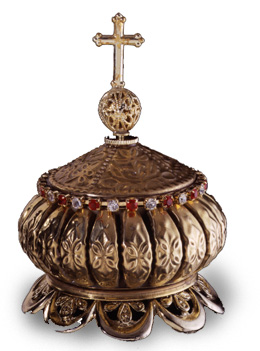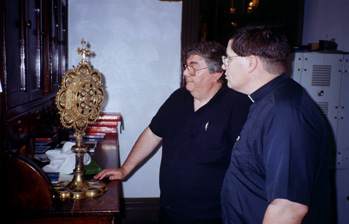Relics of Saints Offered for Sale!
SPECIAL NOTES: TO LOOK UP A PARTICULAR SAINT OR RELIC
BROWSE OUR LISTINGS
Special Information
Please make a selection
Relics of Saints Offered for Sale!
Important information for anyone looking for Holy Relics
Are you looking for an authentic relic for private or public veneration? If so, please read the following warning and information.
 It may sound like the Middle Ages, but unfortunately itís all too true. At the end of the Twentieth Century, on the eve of the Third Millennium, an illicit trade in relics (authentic or otherwise) is flourishing. A number of antique dealers and profiteers have somehow obtained relics of the saints - fragments of their bodies or clothing, or even relics of Jesus Christ such as splinters of the True Cross - and are selling them at incredibly inflated prices, at enormous profit to themselves, without any regard for the sacred character of these objects or for the law of the Church (the source of these relics) which strictly forbids such activities. These sales are taking place in antique shops and flea markets and even on the internet. Typically hundreds of dollars are charged for relics that originally must have been obtained from Church sources for a minimal donation of perhaps 15 dollars (for what donation means in this context, see below). Some relics have even fetched over 1000 dollars, 95 percent of which is profit for the dealer.
It may sound like the Middle Ages, but unfortunately itís all too true. At the end of the Twentieth Century, on the eve of the Third Millennium, an illicit trade in relics (authentic or otherwise) is flourishing. A number of antique dealers and profiteers have somehow obtained relics of the saints - fragments of their bodies or clothing, or even relics of Jesus Christ such as splinters of the True Cross - and are selling them at incredibly inflated prices, at enormous profit to themselves, without any regard for the sacred character of these objects or for the law of the Church (the source of these relics) which strictly forbids such activities. These sales are taking place in antique shops and flea markets and even on the internet. Typically hundreds of dollars are charged for relics that originally must have been obtained from Church sources for a minimal donation of perhaps 15 dollars (for what donation means in this context, see below). Some relics have even fetched over 1000 dollars, 95 percent of which is profit for the dealer.
The information provided by these dealers is frequently inaccurate, and displays their ignorance of these matters. Often they seem to want to ensnare vulnerable or desperate people, for example by suggesting that the relics they are selling might work miracles. The situation is made worse when relics are offered at auction, as desperate people may go to any lengths and thus increase the dealerís profit by bidding against each other. This trade is both cynical and sacrilegious, and since it may be assumed that those who wish to obtain relics are devout Christians of some sort, this information has been posted here as a warning and a guide.
Beware of Fraud!
Without pointing a finger in any particular direction, it is worth pointing out that in any market where objects have a value because of their associations there is always the possibility of fakes being passed off as the real thing. Equally it is worth bearing in mind that the source of relics offered for sale by intermediaries is not always clear. It is a fact that from time to time relics are stolen from churches, and it is also a fact that thieves usually only steal what they can sell. Be warned.
______________________________________________
Misleading claims often made by the dealers
In charity, we must assume that the false claims sometimes made by dealers are a result of their ignorance rather than a deliberate attempt to deceive. Nonetheless you should be aware of these typical misleading claims.
First Class relics
Dealers sometimes state that the relics they offer are first class when there is no evidence that this is so. They seem to assume that anything that has been sealed into a theca (the round metal locket used to contain relics) is a first class relic. Not so! Second and third class relics are frequently distributed in this way. If the authentication document has been lost and the label on the relic doesnít say what it is, it cannot be safely claimed that a relic is first class. (First class relics are parts of the bodies of the saints, such as fragments of bone, or the instruments of Our Lord's Passion such as the True Cross. Nothing else whatever is a first class relic, and strictly speaking only these are canonically entitled to be called relics at all. Other items that the saints used in their lives such as clothing are called second class relics; third class relics are simply objects that have been touched to first or second class relics.)
Relics are Rare or Unique
Dealers try to maximise their profit by saying that a relic is rare or unique or that ìthis may be your only chance to obtain this highly sought after relic, etc. This is just rubbish. Relics were, and are, distributed in tens of thousands from religious orders and from the relic office in Rome. Remember that the items being sold were obtained from these sources originally without any difficulty, and probably for about a twentieth of the price that you are being asked to pay. Donít be taken in!
Documentation from Rome
Most relics when originally issued are accompanied by a document of authentication warranting the veneration of the relic. Dealers like to make much of these if they have them, stressing irrelevant facts such as the number of tassels on the seal (an heraldic device which has nothing to do with the relic or the degree of authority attached to the authentication). But the dealers, it seems, cannot read Latin, or they would realise that the document is more than just a guarantee of authenticity. It is a legal document which probably constitutes a contract, as it usually contains a clause stating that the relic may be kept by the person to whom it is given, or given to another, in accordance with the norms of ecclesiastical law (which forbids the sale of relics). Now, you donít have to sign anything to be party to a contract - for example, when you break the seal on a packet of software you are automatically bound by the conditions of use. Likewise anyone who accepts a relic accepts the conditions stated in the accompanying document. A contract is still a contract even if written in Latin!

"Donation"
When relics are obtained from Church sources a donation is usually asked to cover the cost of the theca (the metal container) and other expenses. This is typically fifteen dollars (obviously more if the container is silver etc.). Some dealers imitate this by saying that their inflated price is a ìdonationî. Now, clearly, a donation is simply to cover costs. Anything more than this is not a donation, it is a profit; you can call it a ìdonationî or anything else if you want to but that won't alter the facts. You are only paying for the container, the relic is a gift Just try selling an empty theca and see how far you get...
Relic cards and medals wrongly described.
Small cards and medals with relics stuck on them are distributed in very large numbers by religious orders, often to promote a beatification or canonisation, and are either given away free or for a very nominal donation. Usually these are third class relics of which there is an unlimited supply, typically ìex indumentis (pieces of cloth which have touched the saintís tomb). Dealers sometimes wrongly state that these relics are pieces of the saintís clothing, rare objects, etc. These have no financial value, and there is no justification for charging anything beyond the cost of postage for them.
Papal seal
Any bishop or religious order can issue relics and attach their seals to the theca and the accompanying document. The Pope, however, never does so (he is a world leader who has more important things to do with his time - for comparison, can you imagine the President of the USA personally signing driverís licenses?). Claims that the seals are Papal just show the ignorance of the dealer.
______________________________________
So how can I obtain a relic?
It is important to remember that you donít have to own relics in order to have the spiritual benefits of venerating them. All Catholic and Orthodox Churches, and some Anglican (Episcopalian) ones, have relics, at the very least sealed into the Altars, and sometimes on display in large collections. You can visit these any time the Church is open. Nonetheless, there is nothing wrong with desiring also to have your own relics for private veneration if you can provide a suitable place for them to be honoured.
Is it ever justifiable to buy relics from antique dealers?
Sometimes, yes, but caution is needed. Whilst the sale of relics is sacrilege (technically it is simony, the sale of spiritual goods, cf. Acts 8 18-24) it is permissible to buy relics in order to save them from desecration. However, a principle of proportionality applies, that is, the money offered should be in proportion to the good to be achieved. Thus it would not be justifiable to purchase a relic if the good of rescuing that relic was less (in a reasonable judgment) than would be achieved by devoting the same amount of money to other objects such as the poor or homeless. Thus, generally, it will not be justifiable to spend very large amounts of money rescuing relics, although there may be exceptional circumstances. The possibility that rescuing a relic may encourage a market to develop should also be considered.
Relics should never be bought at auction, however - buyers just end up bidding against other people who are also trying to rescue the relics.
So are there any legitimate sources of relics?
Yes! Parish Churches and priests who wish to obtain first class relics for public veneration may apply to the Vicariate in Rome. A vast store of relics is preserved there for this purpose. You will need to provide proof of status, and you may be asked for a letter from your Bishop to approve the request. The Vicariate no longer distributes relics for private veneration, however, in order to avoid abuses.
Some religious orders and jurisdictions do provide first class relics for private veneration. For example the Mother Seton Shrine in Baltimore distributes first class relics of St. Elizabeth Ann Seton. The Eparchy of St. Maron of Brooklyn sometimes has first class relics of Blessed Rafka and Blessed Al-Hardini. In addition, if you go on pilgrimage to any shrine it is worth asking in the official gift shop or sacristy as relics are sometimes to be obtained from these sources.
Relic cards and medals with second or third class relics are widely available in Catholic bookstores or from religious orders. If there is any particular saint you are interested in look up the address of the provincial postulator of their order in your local Catholic directory and write and ask. In addition, you can make your own third class relics if you visit a saintís tomb just by touching the tomb with a piece of cloth. This method is sanctioned by a very ancient tradition - there are records of pilgrims to St. Peterís tomb doing just this in the fifth century.
|
|
|
|
|
|
|